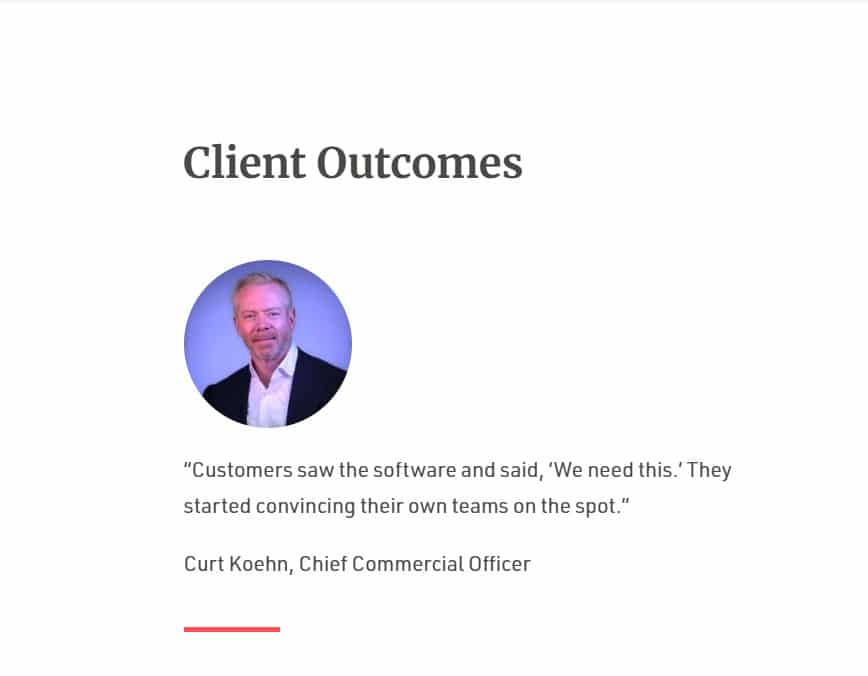What happens when great stories hide their best parts several scrolls down the page? In our case studies portfolio, potential clients missed a lot of what makes Atomic’s work stand out. So we set out to fix it and learned a lot along the way.
In my first year at Atomic Object as a marketing specialist, I inherited the task of writing case studies for our projects. A good case study documents how a real client challenge was solved, what it took to get there, and, of course, why that work mattered to the client’s business.
And these are really important sales assets: a 2023 Demand Gen Content Preferences Study found that 62% of B2B buyers rely on practical content such as case studies when weighing a purchase decision.
Where We Were Losing Readers
Early on, I noticed that our case studies read like stories. Compelling narratives, but long enough for a reader to lose interest or ignore completely if they’re in a hurry. Some ran beyond 1,000 words and had sections that looked like this:

As a new employee, even though I was genuinely curious about our past work and they were well written case studies, I felt disinterested in reading more than one at a time.
Considering I was being paid to read them, this felt like a clear problem. If the format slowed me down, it surely slowed the busy CTOs and engineering managers who skim our site before reaching out.
Our Redesign Playbook
As any marketer knows, reformatting your website isn’t simple. Working with Atomic’s designers, it took several weeks to organize and restructure our case studies in a way that we felt modernized them how we wished. The process took several rounds of iteration before landing on a design that we felt communicated everything more clearly, concisely, and business outcome focused.
Here are the following changes our marketing team made to the site, which I would consider best practices for any portfolio:
Surface value quickly and back up your claims with data

It’s exceptionally important to connect what matters about this work to what our clients care about, which is why after a concise introduction, key impact results are the first thing to follow. That could be metrics like their revenue impact, funding raised, costs saved, operational efficiency gains, or something else that had an impact on the business’ growth, risk, or costs.
We want this all highlighted in the introduction, not buried in a paragraph, to legitimize the value of our services.
Make it skimmable.
Make the information easy to read. Consider how busy custom software buyers likely are, and what information they’d really want to know before making a decision. They’re not looking for fluff, and anything messy or poorly formatted isn’t going to get their attention. For our site, this looked like:
- Shorter paragraphs: No paragraph exceeds four sentences.
- Bullet points for key information: Project deliverables and technical details are in a list.
- Consistent structure: Every single case study follows the same template.
Use strong client quotes, and make them human.
 Client quotes were always central to our case studies, but I wanted to highlight it as a best practice. There’s nothing we could say that could speak more strongly to our work than words straight from the client’s mouth.
Client quotes were always central to our case studies, but I wanted to highlight it as a best practice. There’s nothing we could say that could speak more strongly to our work than words straight from the client’s mouth.
However, a change we made was adding the quote author’s photo. This adds to the authenticity, and hopefully helps readers with similar roles identify with our client.
Create a separate section for the buyers looking for the technical details.

Not everyone wants to know which frameworks and coding languages we used, but the readers who do want that information want to find it quickly. We now include a “Technical Highlights” section at the end that breaks down the tools, platforms, and technical execution.
By putting technical details in their own section, we make it easy for readers to focus on the areas that are most valuable to them.
Takeaways for Marketing Teams
Here are a few takeaways from this work.
Audit your existing content periodically.
Regularly look at your case studies with fresh eyes (or have the new hire do it, like I did!). Or better yet, have someone unfamiliar with your company review them. What questions do they have? Where do they lose interest?
Make data collection a priority during project execution.
Given that most website visitors spent seconds, not minutes, on our case study pages, I believe that the three business-impact data points we placed near the top of the case study can be some of the most powerful parts of the story. The best way to capture this data is by building measurement into the project from the start, then confirming with the client which outcomes mattered most. Sometimes, clients may not have access to strong data, so it’s worth being proactive.
This redesign reinforced that effective marketing collateral is about telling your story in a way that respects how your audience wants to consume information. Sometimes, the best content strategy is simply making great information more accessible!

